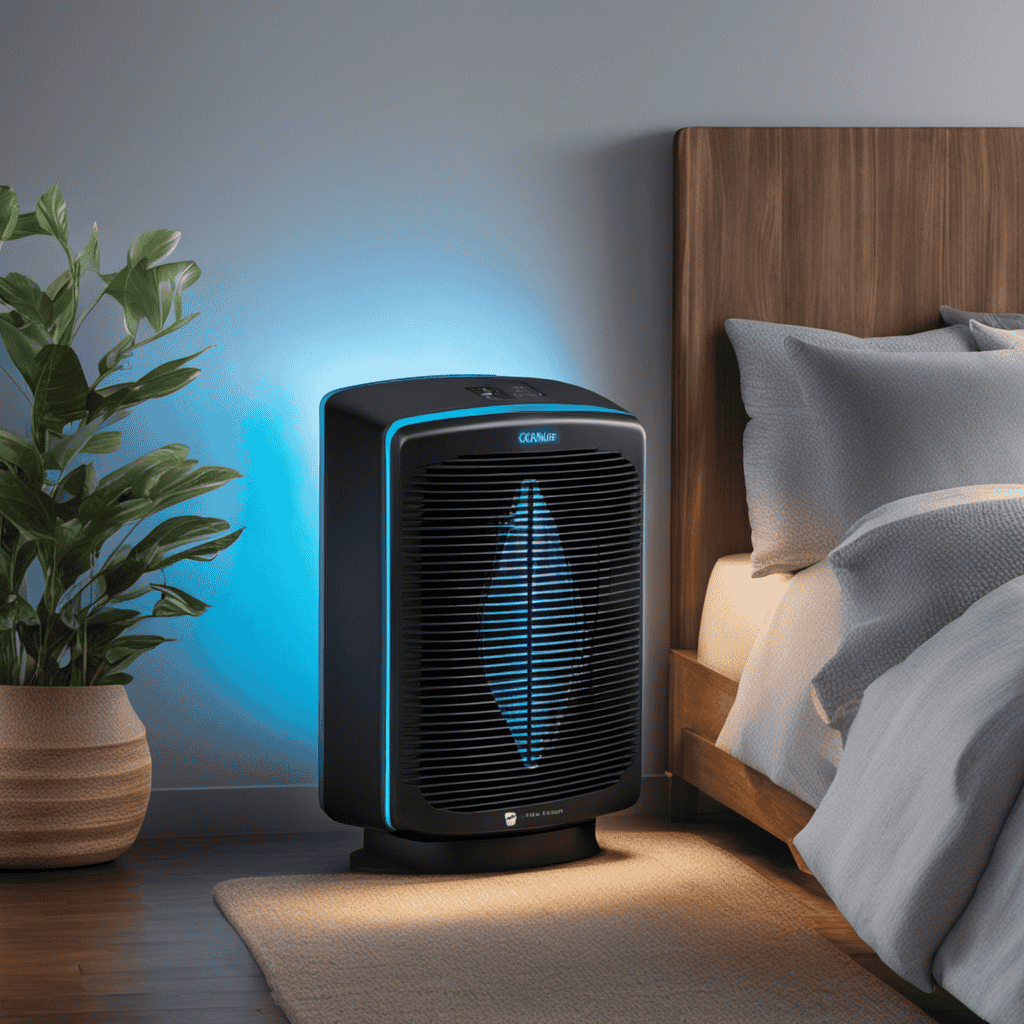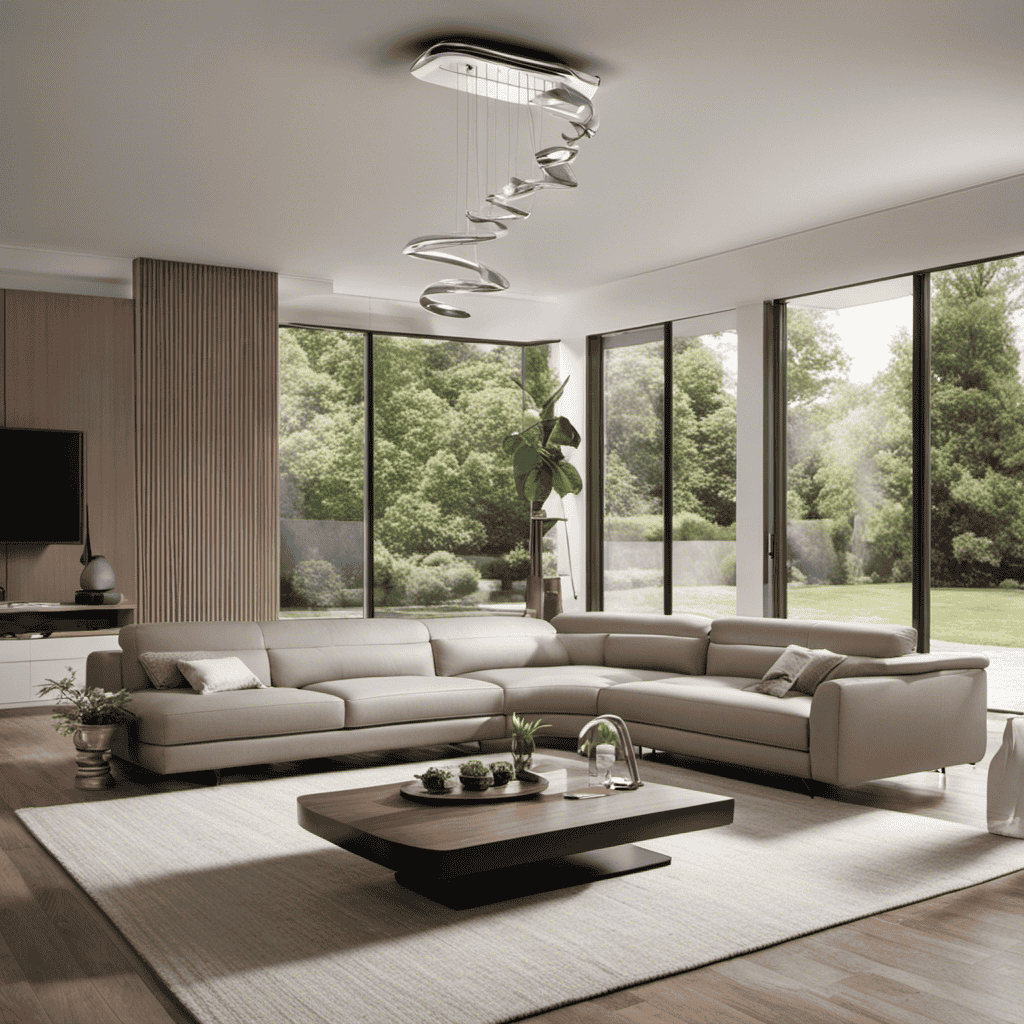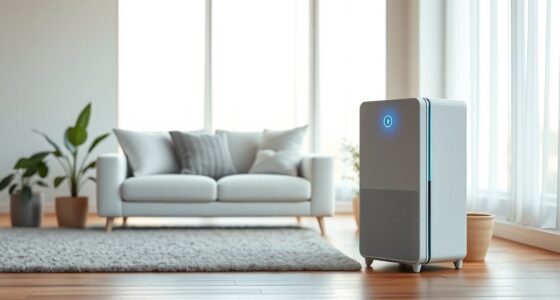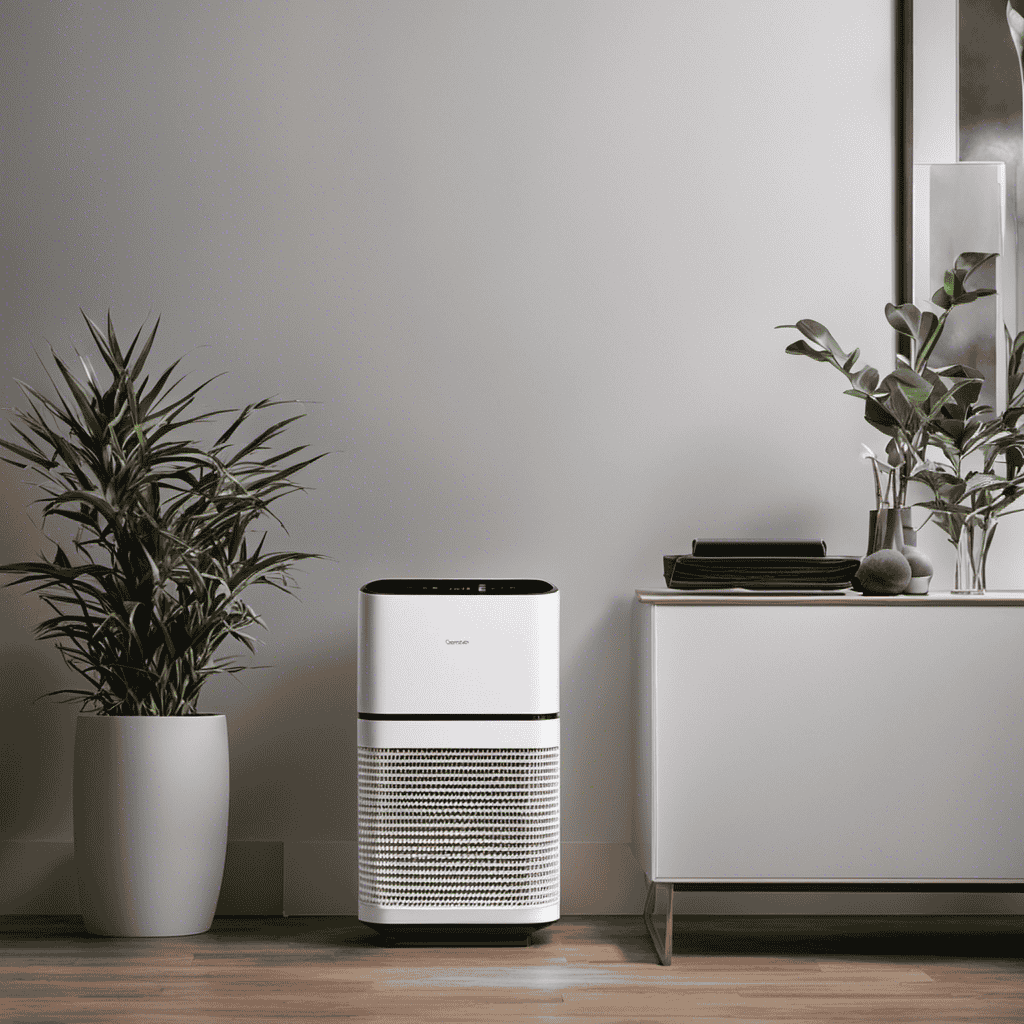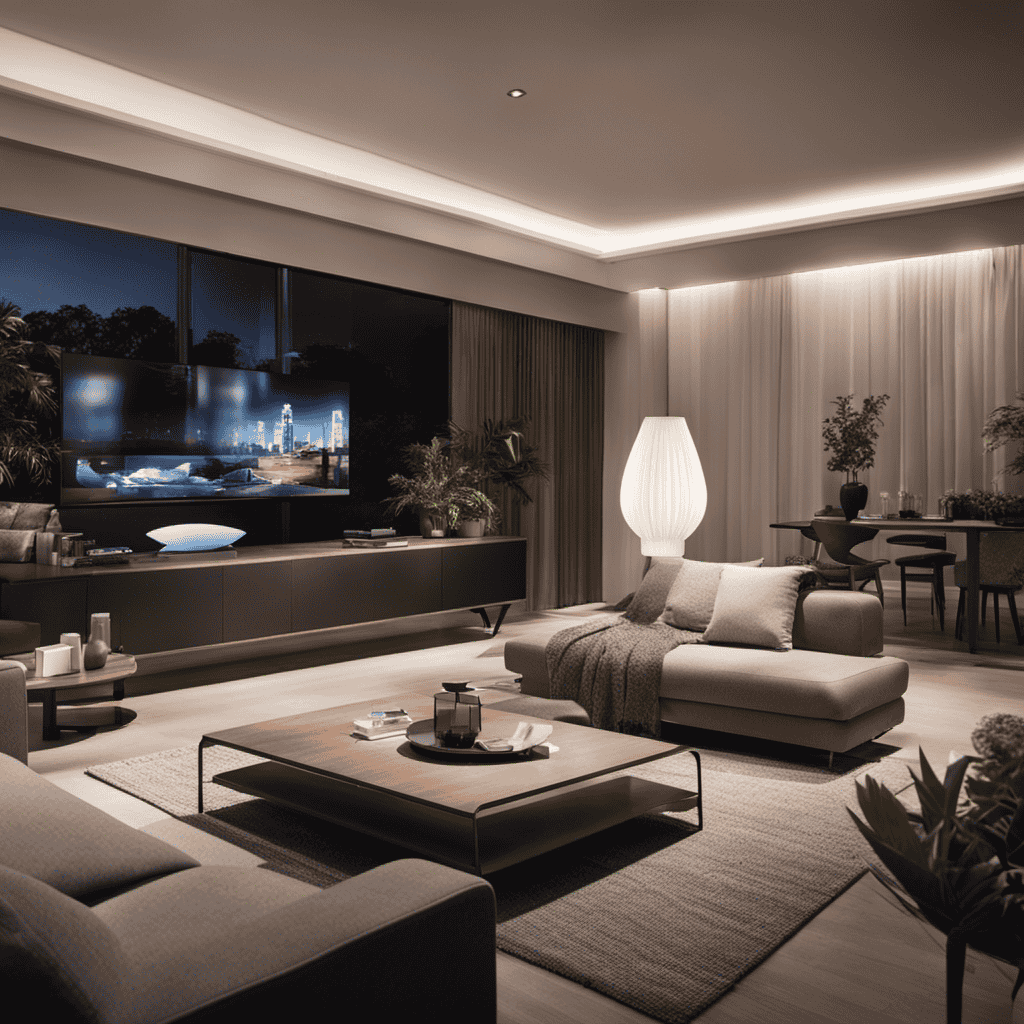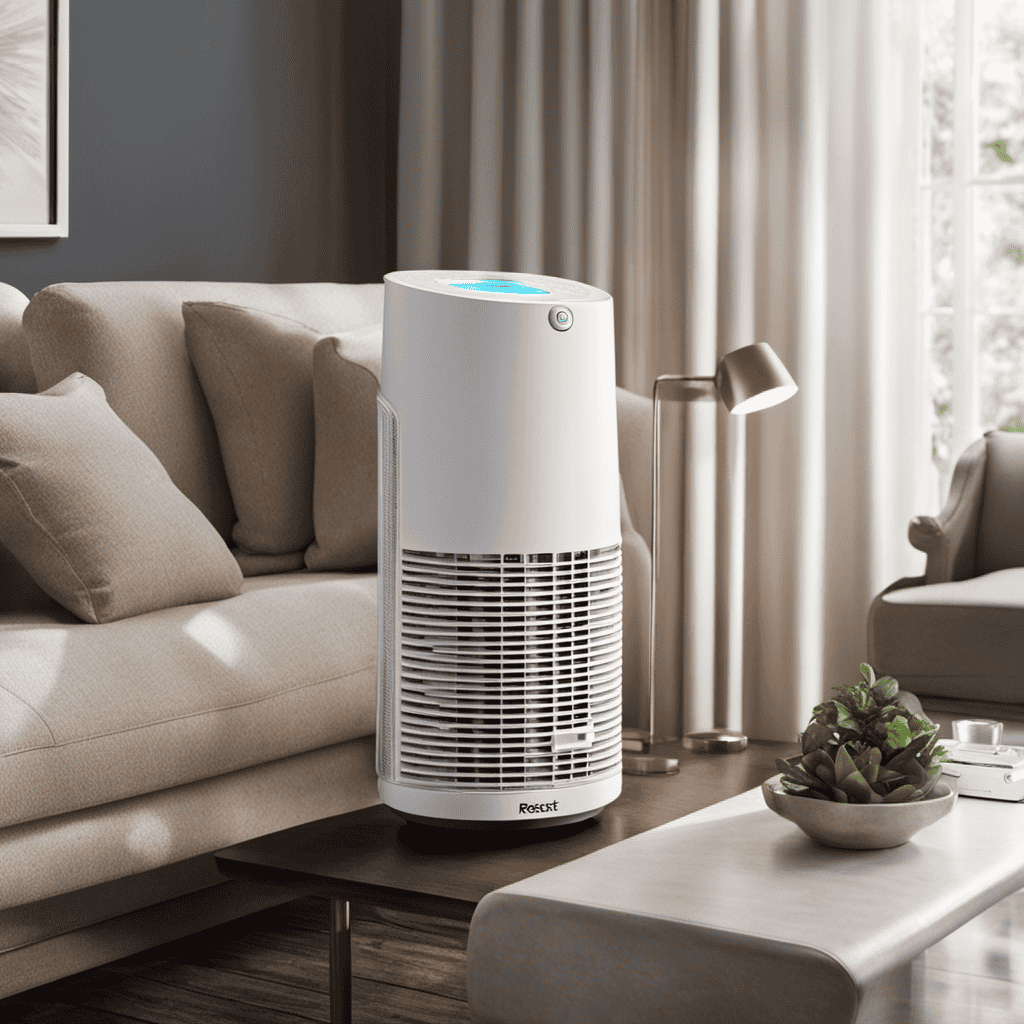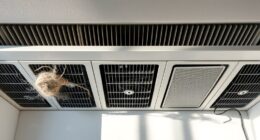Are you aware that indoor air can be up to five times more polluted than outdoor air? That’s why a lot of individuals opt for ozone air purifiers to enhance the air quality in their homes.
But it’s important to use these devices safely to avoid potential risks. In this article, I will guide you through the proper usage of ozone air purifiers, including understanding ozone levels, placement and ventilation, choosing a purifier with safety features, recommended usage time and intervals, and tips for monitoring and maintaining safety.
Key Takeaways
- Understand the potential risks and health effects of ozone air purifiers.
- Follow safety guidelines and regulations for proper usage of ozone air purifiers.
- Use ozone air purifiers in well-ventilated areas and avoid prolonged exposure to high ozone levels.
- Regularly monitor the air quality in your home and follow maintenance requirements for optimal performance and safety.
Potential Risks of Ozone Air Purifiers
You should be aware of the potential risks of using ozone air purifiers. While these devices are marketed as effective in removing odors and pollutants from the air, they can also pose health risks.
Ozone, a highly reactive gas, can irritate the respiratory system and cause breathing difficulties. Prolonged exposure to high levels of ozone can even lead to lung damage.
It is important to understand that ozone air purifiers are not recommended for use in occupied spaces, as they can emit ozone at levels that exceed safety guidelines.
If you are concerned about indoor air quality, there are alternatives to ozone air purifiers that are safer and equally effective. These include HEPA air purifiers, activated carbon filters, and ionizers.
Now that you know the potential risks associated with ozone air purifiers, let’s move on to understanding ozone levels and safety guidelines.
Understanding Ozone Levels and Safety Guidelines
When it comes to ozone, it’s important to understand the potential health risks associated with exposure.
Ozone can irritate the respiratory system, cause coughing and shortness of breath, and even lead to lung damage.
However, there are safety measures that can be taken to minimize these risks. These include ensuring proper ventilation and avoiding prolonged exposure to high ozone levels.
Ozone and Health Risks
If used incorrectly, an ozone air purifier can pose health risks for you. Ozone exposure effects can range from mild irritation of the respiratory system to more serious problems such as decreased lung function and increased susceptibility to respiratory infections. It is important to understand the potential risks associated with ozone before using an air purifier that generates it.
Here are three reasons why ozone exposure should be taken seriously:
-
Ozone can cause chest pain, coughing, and shortness of breath, especially in individuals with pre-existing respiratory conditions.
-
Prolonged exposure to high levels of ozone can lead to permanent lung damage and worsen existing respiratory diseases.
-
Ozone has been linked to increased risk of asthma attacks and other respiratory symptoms.
To ensure your safety, it is crucial to follow ozone regulation guidelines and take necessary precautions when using an ozone air purifier.
With that in mind, let’s explore some ozone safety measures.
Ozone Safety Measures
To ensure you stay safe, it’s important to familiarize yourself with ozone safety measures. Ozone exposure can have harmful effects on your health, particularly if you inhale high levels of ozone. Ozone inhalation can lead to respiratory issues, such as chest pain, coughing, throat irritation, and shortness of breath. It can also exacerbate existing respiratory conditions, like asthma or bronchitis.
To minimize the risk of ozone exposure, it is crucial to follow certain safety measures. First, make sure to read and understand the manufacturer’s instructions for your ozone air purifier. Additionally, never exceed the recommended ozone levels and duration of use.
It’s essential to use the ozone air purifier in a well-ventilated area to allow for proper airflow and prevent the buildup of ozone. This will be further discussed in the subsequent section about proper placement and ventilation for ozone air purifiers.
Proper Placement and Ventilation for Ozone Air Purifiers
When it comes to using ozone air purifiers safely, two key factors to consider are safe ozone dispersion and optimal air circulation.
Safe ozone dispersion ensures that the ozone produced by the purifier is evenly distributed throughout the room, minimizing the risks associated with high ozone concentrations in one area.
Optimal air circulation, on the other hand, ensures that the ozone is effectively circulated and mixed with the indoor air, allowing for better purification results.
Both of these factors play a crucial role in maximizing the effectiveness of ozone air purifiers while maintaining a safe environment.
Safe Ozone Dispersion
For safe ozone dispersion, make sure to position the air purifier in a well-ventilated area. This will help prevent excessive ozone exposure and ensure a healthier living environment. Here are three important things to consider when using an ozone air purifier:
-
Monitor Safe Ozone Levels: It is crucial to check the ozone levels in your home regularly. Keep them within the recommended range of 0.05 to 0.08 parts per million (ppm) for human safety. High ozone levels can cause respiratory issues and other health problems.
-
Limit Ozone Exposure Time: Limit the use of ozone air purifiers to short periods, such as when you’re not in the room or when there is a specific need. Prolonged exposure to ozone can be harmful to your health.
-
Follow Manufacturer’s Instructions: Read and follow the instructions provided by the manufacturer carefully. This will ensure proper usage and prevent any potential risks associated with ozone air purifiers.
Optimal Air Circulation
Make sure your living space has adequate air circulation to promote a healthier environment. Good air circulation helps to maintain optimal indoor air quality and reduces the risk of pollutants accumulating in your home.
One effective way to ensure proper air circulation is by using air quality monitoring devices. These devices can measure the levels of pollutants in your home and provide valuable information on how to improve air circulation.
In addition, implementing ozone removal techniques can further enhance air quality. Ozone, although beneficial in the upper atmosphere, can be harmful when present in high concentrations indoors. Ozone air purifiers equipped with ozone removal techniques can effectively remove excess ozone from the air, ensuring a safer living environment.
How to Choose an Ozone Air Purifier With Safety Features
It’s important to consider safety features when choosing an ozone air purifier. With so many options available on the market, it’s crucial to prioritize the well-being of yourself and your loved ones. Here are three key safety features to look for:
-
Ozone-free alternatives: Instead of choosing an ozone air purifier, opt for devices that use alternative technologies such as HEPA filters or activated carbon to effectively purify the air without generating ozone. This ensures that you can breathe clean air without any potential harm.
-
VOC sensors: Look for purifiers equipped with volatile organic compound (VOC) sensors. These sensors detect harmful chemicals in the air and adjust the purification settings accordingly, providing an added layer of protection against indoor air pollution.
-
Timer and automatic shut-off: A purifier with a built-in timer and automatic shut-off feature allows you to set specific operating hours and ensures that the device is not running continuously, minimizing any potential risks associated with prolonged exposure to ozone or other pollutants.
Choosing an ozone air purifier with these safety features will not only provide you with cleaner air but also peace of mind knowing that you have made a safe and informed decision.
Common misconceptions about ozone air purifiers:
-
Ozone is not harmful: Many people believe that ozone is harmless and even beneficial. However, high levels of ozone can irritate the respiratory system, trigger asthma attacks, and damage lung tissue.
-
Ozone eliminates all pollutants: While ozone can neutralize certain odors and pollutants, it is not effective against all types of indoor air contaminants, such as dust, pollen, and pet dander. It’s important to choose a purifier that targets specific pollutants you are concerned about.
-
More ozone means better purification: Some people mistakenly believe that higher ozone output leads to better air purification. However, this is not true. Ozone should be used in controlled amounts to avoid any potential health risks.
Recommended Usage Time and Intervals for Ozone Air Purifiers
To ensure your safety and prevent any potential risks, it’s important to follow recommended usage time and intervals when using an ozone air purifier.
Ozone air purifiers work by releasing ozone into the air to eliminate odors and kill bacteria. However, excessive exposure to ozone can have negative health effects.
The recommended usage guidelines state that you should only run the ozone air purifier for a maximum of two hours at a time. After each usage, it is recommended to allow a minimum of two hours for the ozone levels to dissipate before re-entering the room. This will help minimize the potential health effects of ozone exposure.
It is also important to keep the room well-ventilated during and after the usage of the ozone air purifier to further reduce any risks.
Tips for Monitoring and Maintaining Ozone Air Purifier Safety
Monitoring and maintaining the safety of your ozone air purifier is crucial to ensure optimal performance and minimize potential health risks. Here are three important tips to help you effectively monitor and maintain your ozone air purifier:
-
Regularly check the effectiveness of your ozone air purifier by monitoring the air quality in your home. This can be done using an air quality monitor or by observing any changes in symptoms related to air pollution, such as allergies or respiratory issues.
-
Follow the manufacturer’s maintenance requirements to keep your ozone air purifier running smoothly. This may include cleaning or replacing filters, cleaning the unit itself, and ensuring proper ventilation.
-
Keep track of the ozone output levels of your air purifier. It’s important to stay within safe ozone concentration limits to avoid potential health risks. This can be done by referring to the device’s user manual or seeking guidance from a professional.
Frequently Asked Questions
Can Ozone Air Purifiers Completely Eliminate All Types of Indoor Air Pollutants?
Ozone air purifiers can effectively reduce indoor air pollutants but may not completely eliminate all types. It’s important to consider other factors like ventilation and source control for optimal indoor air quality.
Are Ozone Air Purifiers Safe to Use Around Children and Pets?
Ozone air purifiers are effective at removing indoor air pollutants, but there are potential risks and precautions to consider. It’s important to use them safely, especially around children and pets, to avoid long-term effects on their health.
Can Ozone Air Purifiers Help With Removing Odors From Cooking or Smoking?
Ozone air purifiers can be effective in neutralizing cooking odors and reducing secondhand smoke. However, it is important to use them safely and follow guidelines to avoid potential health risks.
How Long Does It Take for Ozone Levels to Dissipate After Using an Ozone Air Purifier?
After using an ozone air purifier, it takes several hours for ozone levels to dissipate. To use an ozone air purifier safely, it is important to follow the manufacturer’s instructions and take necessary precautions.
Are There Any Specific Health Conditions or Sensitivities That Make Using Ozone Air Purifiers Unsafe?
Some health conditions and sensitivities can make using ozone air purifiers unsafe. For example, individuals with asthma or respiratory issues may experience aggravated symptoms due to the high ozone levels emitted by these purifiers.
Conclusion
In conclusion, using an ozone air purifier safely requires careful consideration and adherence to safety guidelines. By understanding the potential risks and proper placement of the device, you can ensure effective air purification without compromising your health.
Selecting an ozone air purifier with safety features, such as adjustable ozone levels and automatic shut-off, is crucial. Additionally, monitoring usage time and intervals and regularly maintaining the purifier will help guarantee its safe and efficient operation.
With these precautions in place, you can enjoy clean and fresh air in your living space.
